#bioregional
Text
What is Herbalism?
For me, herbalism is everything. It affects everything I do. The way I walk in the world; the way I relate to people. I can be walking streets in an inner city, and I’ll be identifying the weeds growing out of the cracks in the pavement. Weeding the garden is complicated. A weed is an unwanted plant. Well, there are so few unwanted plants in my mind, how do I choose what goes into the kitchen or…

View On WordPress
#alternative medicine#bioregional#botanical medicine#education#foraging#herbal medicine#herbalism#holistic health#natural healing#natural health#wildcrafting
0 notes
Text
Solarpunk Art 2023 (BIOREGIONS)
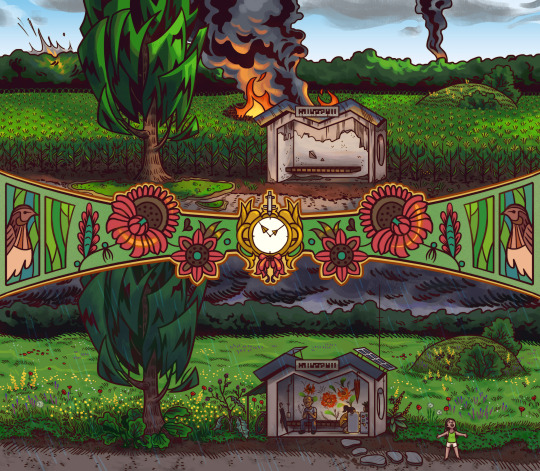
Temperate Grassland in Ukraine by @the.lemonaut.
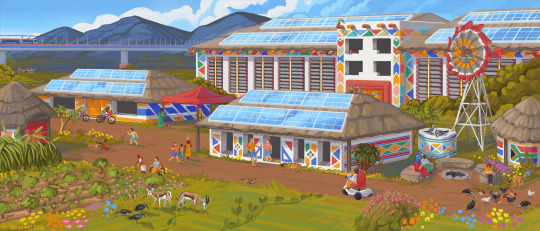
Desert/Xeric Shrublands in South Africa by @draakart

Mediterranean Forests/Scrubs in Southern California, USA by @helentadesseart
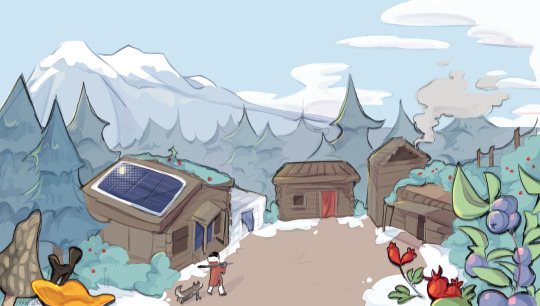
Boreal Forest by @_frandszk.

Mediterranean Forest/Scrubs in Tijuana, Mexico by Limonarte
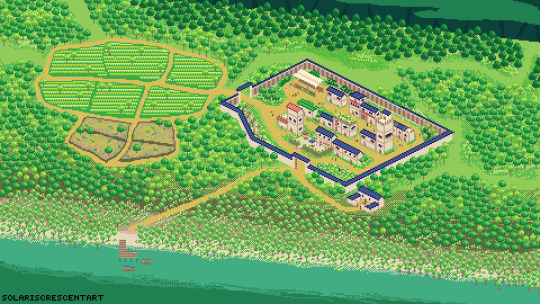
Subtropical Evergreen Forests in South China & Vietnam by @solariscrescentart

Tropical & Subtropical Moist Broadleaf Forests in the Philippines by @lacan.lacapat

Temperate Broadleaf & Mixed Forests in the Ozark Highlands of the USA by Xiantifa

Temperate Broadleaf & Mixed Forests by Arikadough
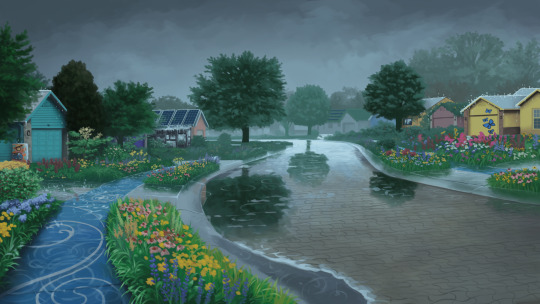
Temperate Broadleaf & Mixed Forests in Indiana, USA by Toby Raab
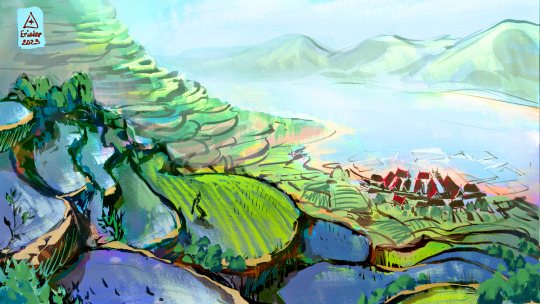

Subtropical Evergreen Forests in South East Asia by @erisdar_art






Various Bioregions by Dustin Jacobus (@solarpunkart)
754 notes
·
View notes
Text
Working with Collective Spirits: Plants and Animals
UPG Warning: Content is based on personal experience.
Individual vs Collective
The difference between an individual spirit and a spirit collective is pretty simple. Working with an individual involves connecting with a being who has their own personality traits and motives. Some are well-known (like the Witch Father), some are spirits of the dead or specific ancestors, some are tied to certain individuals, families, and locations, and some are Nameless or long-forgotten.
A spirit collective is sort of like a current that runs through all living beings and objects. It can be as broad or as narrow as you wish. For example, you can work with the spirit of all trees or you can work with the spirit of Maples.
This is easy to conceptualize if you're an animist who believes that all life is connected and there is spirit in all things. Imagine the life force that runs through us all is a large river, and specific spiritual collectives are the tributaries.
To put it simply, if you are leaving offerings to the spirit of a dead rabbit that you found on the side of the road, you are engaging with an individual. If you are leaving an offering for all rabbits in your immediate area you are working with a collective.
Overlap
Sometimes a spirit can exist both as a collective and an individual. For example, the spirit of your house or local river may be made up of several different spirits and go by many names.
Additionally, if I'm working with the spirit of Apple Trees, one could assume that I'm working with millions of apple tree spirits formed into a single collective.
Connecting with Collective Spirits
If you're like me, you need to have an emotional and physical connection to certain spirits before you begin involving them in workings. This usually means that I'm working with plants and animals that exist in my own local biosphere.
Here are some ways to start getting to know plant and animal spirit collectives:
Meet them in their own environment: For example, if you want to work with the spirit of Oak Trees, start by spending time where they are known to grow. You can take a walk through a local forest or visit individual trees in a park or your own backyard.
Learn about them: Find reading material about the species you're interested in. Learn about their native habitat, behavior, diet, growth rate, myth and folklore, the time of year that they're present, etc. I find that engaging with a plant or animal on a scientific and material level helps you get to know them more personally and will therefore strengthen any spiritual relationships you wish to pursue.
Care for them: If you're looking to work with the spirit of Lilac, plant and care for a lilac shrub. If you want to work with the spirit of Hummingbirds, install a feeder. If you're interested in the spirit of cats or dogs, start fostering or volunteering for a rescue.
Observe them: If the collective that you want to work with is that of an animal, take some time to watch them from a safe distance in their natural environment. If you're working with a plant, feel free to get up close and personal as long as it's safe and you are not disturbing a protected species.
Veneration
I want to start by saying that veneration is not something that is required when working with spirits and in some cases can actually be a bit of a hindrance. However, it is beneficial if your goal is to emotionally connect with spirits, gain favor with them, and establish highly personal ongoing relationships. My workings boast a higher success rate and rich personal meaning when I am working with a spirit who I have developed a connection with through consistent offerings and acts of kindness.
Physical offerings
The most common form of veneration is a physical offering. They can be left at an altar or outdoors in the natural habitat of the collective spirit that you plan on working with.
Outdoor offerings should be left with great care for the local ecosystem. For plants I usually leave compost or fresh water. I will also drop specific food items in my compost bin as an offering to whatever plant spirit I'm working with that day.
For animals, things can be a bit more complicated. When offering food, it's crucial to be 100% certain that it is safe for wildlife to consume and that you aren't leaving so much so often that animals start to rely on you for food. I usually stick to birdseed, acorns, peanuts, fresh fruit and greens, unsalted sunflower seeds, and cat food for the strays. Keep in mind that food is left only in my own backyard (never, like, the woods) and never in high abundance. When in doubt, a bowl of fresh water is a more than sufficient offering.
Indoor offerings allow much more room for variety. Food items that cannot be left outside (like meat, cheese, confections, and alcohol) can be safely offered this way. You also won't be limited to compostable items and will be free to leave assorted trinkets, jewelry, or whatever you find appropriate.
Acts of Kindness
Personally I feel that acts of kindness are the best way to venerate plant and animal collectives. Not only are you building real-life relationships and connections, but you are making an active difference in the lives of actual living beings and this will always be well-received from a magical perspective. In my practice, how I interact with the physical world is in direct relation to that of the spirit world, so this is an important step for me.
Some acts of service can overlap with physical offerings such as leaving bowls of water for the wildlife on a hot day, filling a bird feeder, or watering a plant, but there are countless other options to choose from, including activism, rewilding, rescue, volunteering, and habitat restoration.
For example, if I want to work with the spirit of Monarch Butterflies, I may start a monarch waystation full of milkweed and nectar-producing native plants. If I'm venerating the spirit of Black-Eyed Susan, I could scatter some seeds on the roadside. If I'm working with the spirit of domestic dogs I might feel compelled to volunteer at a local shelter. Perhaps the spirit collective that I want to work with is fresh-water dwelling and I opt to help clean a local river.
In addition to physical offerings and acts of service, some ideas include constructing miniature altars and spirit houses, creating devotional art, and wearing devotional jewelry.
Working with Collective Spirits
There are many benefits to working with spirit collectives. They can be involved in spellwork, called directly during divination, and petitioned to help advance certain skills. This is where knowledge gained through study and observation are put to use. Plant and animal collectives come with their own folklore and symbolism, natural skill-sets, and physical and behavioral qualities which are useful in magical workings. Once you have a handful of spirit types that you're familiar with you can start putting everything into practice.
One way to begin choosing which collectives you incorporate into which workings is through divination. Break out your cards or bag of charms, call upon the spirit of your choosing, and ask them what their skills are. If you have researched the plant or animal in the past or already have a rough list of correspondences, you can compare the answers to your existing notes.
Petitioning spirits in magical workings is a great introduction to spirit work and can be easily executed by beginners. For simple workings, it's enough to just call upon the spirit, leave an offering, and ask for assistance. Here are a few simple ideas for getting started:
Divination: Call upon a specific plant or animal collective that corresponds with your question or possesses skills related to the subject at hand. Ask for them for their wisdom and guidance.
Spellwork: Before casting, call upon the collective spirit of your choosing and ask for them to assist you.
Glamours and Ambient Spells: Ask for the collective spirit to lend you some of their qualities, features, or skills, or ask them to bless a physical space or personal astral location with characteristics of their native environment.
Celebrations and Rituals: Invite the collective spirit of certain animals or plants to your ritual. For example, the spirit of Rabbits could be invited to join a Spring Equinox celebration.
Blessing or Enchanting Objects: Ask for the corresponding spirit collective to charm, enchant, or bless an object.
These are just basic concepts. Feel free to get creative and fine-tune some of these ideas to your personal practice. Working with collective animal and plant spirits is extremely rewarding and I've found that my magical skills have grown exponentially since doing so. My awareness of and connection to the natural world has also improved and I find that I notice and am able to identify significantly more plants and wildlife than I used to.
#spirit work#traditional witchcraft#nature magic#witchcraft community#divination#beginner witchcraft#witchblr#witchcraft#spellwork#plant magic#animal symbolism#colletive spirits#bioregional magic
95 notes
·
View notes
Text
Just learned about bioregions??? Insanely cool? You can look up yours on OneEarth.org. Hello from the Celtic Broadleaf Forests!
#solarpunk#hopepunk#cottagepunk#environmentalism#social justice#community#optimism#bright future#climate justice#tidalpunk#bioregions#ecoregions#biogeographic realms#alternative place names#nature#Anglo-Celtic Isles
91 notes
·
View notes
Text
Foraging in Witchcraft

I'm a big fan of working with the land, and one of the easiest ways to do so is by gathering your own plants. This is also free! No having to stop at an occult/metaphysical shop to pick up that random plant you forgot you needed. I will be making individual posts on different plants that can be foraged in my own bioregion, but first we should go over a few tips and housekeeping notes about foraging and witchcraft.
⸙༄𓆤𓆩𓆪❁𓇢𓆸🏵
Contents:
Natural Isn't Always Safe
Laws and Foraging
Invasive vs. Native vs. Naturalized
Animistic Foraging
Conclusion
⸙༄𓆤𓆩𓆪❁𓇢𓆸🏵
Natural Isn't Always Safe
First thing I want to get out of the way is that not everything you find outside is going to be safe to put in your body or even touch. On top of that, not everything that is safe for someone else is going to be safe for you. We each have different bodies and how we react to something will not always be the same. When you first start foraging, it's important to have a guide book that will tell you of any safety measures to take when dealing with a plant. Some will interact with medications in ways that are not healthy, some have fluid that can make your skin photosensitive, and some... some people are just allergic to.
When it comes to medications, you can find contraindications (when not to ingest something) with a quick google search of "[plant name] contraindications." Generally this will give you a safe answer, however always check with your doctor if you are unsure. Better to pay for a consultation than a hospital visit.
Some risks come from the environment that the plant grew in. If you are foraging near train tracks or buildings that could leach lead into the soil, the plants will pick that up as well. Contaminated soil and pesticides sprayed onto the plants can also lead to health risks. Be very mindful of where you are foraging.
Some plants that are safe will also have toxic look-alikes. A famous look-alike is wild carrot and poison hemlock (thank you Oregon Trail video game). Unless you know what characteristics you are looking for, it's very easy to confuse the two plants. One is a delicious snack, while the other is highly toxic (the poison hemlock), to the point of causing muscle death and kidney failure. This isn't to scare you away from foraging. Only to drive home the importance of making sure you know what you are gathering.
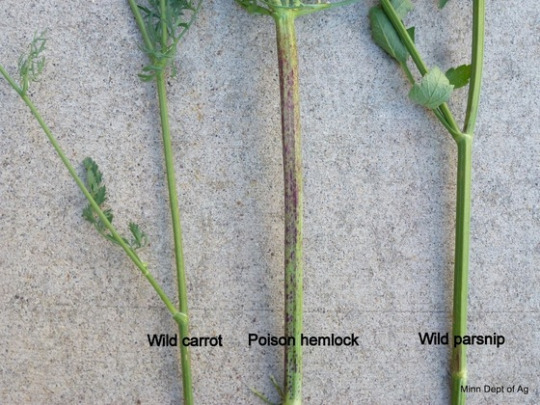
*credit to the Minnesota Department of Agriculture
⸙༄𓆤𓆩𓆪❁𓇢𓆸🏵
Laws and Foraging
I am a resident of the United States so these will be more geared towards that country. It would be to your benefit to look into the foraging laws of your own country/state anyway, as it can still differ. The majority of states in America prohibit foraging on public lands, which makes it really hard for those who don't own their own property. If you live in Alaska and Hawaii, however, congratulations your local government allows it. Even among those states that do allow it, there can be designated areas where it's not allowed such as a nature preserve. Breaking these laws tends to come with a hefty fine and possible jail time, if caught. Though these laws are hard to find with a quick google search, especially for a specific area.
The laws in the United States prohibiting foraging are generally colonial, imperial, classist, and racist (surprise, surprise). Foraging was protected by law well into the 1800s (except for Native Americans who were pushed off their ancestral hunting and gathering grounds), even when doing so on another person's private property. After the Civil War, many newly-freed African-Americans would sell their foraged and hunted goods for an income, while also using the practice to become self-sufficient. The southern plantation owners needed this system to go away so they could chain what used to be their "property" to their old line of enslaved work. Starting with criminal trespass laws. Eventually anti-foraging laws spread to the average white rural American. Outside elites began to believe that the "backwards" people of the countryside, who made a subsistence living off the practice of foraging, fishing and hunting, could not be trusted with the stewardship of the land; using "conservation" as a way to "protect" it from the people who lived there (Linnekin, "Food Law Gone Wild: The Law of Foraging" p.1008-1014).
I do believe we need to protect our resources and lands. However, foraging can be regulated, not outright outlawed as it is. Learning about the plants and animals that live around us and can help us in our lives, leads us to learn more deeply about their role in the environment and just WHY we should protect them...
All this to say, look into your local foraging laws (and how local law enforcement actually enforces them, if they do at all) and then you can decide if you want to follow them or not. At your own risk.
⸙༄𓆤𓆩𓆪❁𓇢𓆸🏵
Invasive vs. Native vs. Naturalized
There is a lot of talk in foraging communities about invasives vs. natives. Sometimes even bringing in naturalized plants. So let's talk a little bit about what these words mean in ecology and how this may effect your foraging habits.
Invasive and naturalized plants have one thing in common; they are both transplanted outside their natural ecosystem. A plant that is invasive in one place, can be naturalized in another. What matters is the impact the plant has on the ecosystem it has been transplanted into.
Invasive = plants or animals that harm regional ecosystems.
Naturalized = plants that have successfully established and reproduced in a new environment, integrating into their new home without inflicting ecological harm.
To make things a bit more complicated, let's introduce the 10% rule. According to the Huron River Watershed Council, "the '10% rule' postulates that of all species introduced to a region outside of their native range, only 10% will survive to reproduce in their adopted environment. This 10% of non-native survivors are often called 'naturalized' plants. Of that 10%, another 10% (or 1% of the original non-native transplants) may thrive to such an extent that they dominant their new home, out competing their native neighbors. These prolific competitors are known as invasive species."
So what makes a native plant? The US Forest Service defines a native plant as "plants [that] are indigenous terrestrial and aquatic species that have evolved and occur naturally in a particular region, ecosystem, and habitat. Species native to North America are generally recognized as those occurring on the continent prior to European settlement."
Some native species can be endangered due to habitat loss from agriculture and/or competing invasive species. It's good to have a list (many state DNR (Department of Natural Resources) will have a list available on their website) printed so you know which ones should be cultivated in your garden if you wish to work with them. Avoiding these and working with invasive species can help with conservation efforts as well. Native species can still be worked with in the wild if they are not endangered.
⸙༄𓆤𓆩𓆪❁𓇢𓆸🏵
Animistic Foraging
You'll often see witches giving advice about asking the plants permission before harvesting. This is from the belief that the plant has a spirit, an animistic belief. Asking permission to harvest isn't the only way we can forage mindfully and with respect to the plant. The way that I do this is by following the Honorable Harvest set out by Robin Wall Kimmerer (a Potawatomi botanist, and the director of the Center for Native Peoples and the Environment at the State University of New York College of Environmental Science and Forestry) in her book "Braiding Sweetgrass."
Know the ways of the ones who take care of you, so you may take care of them.
Introduce yourself. Be accountable as the one who comes asking for life.
Ask permission before taking and abide by the answer.
Never take the first, never take the last.
Take only what you need.
Take only what is given.
Never take more than half. Leave some for others.
Harvest in a way that minimizes harm.
Use it respectfully. Never waste what you have taken.
Share.
Give thanks for what you have been given.
Give a gift in reciprocity for what you have been given.
Sustain the ones who sustain you and the earth will last forever.
The first rule really helps you to follow the rest of them. Know the plant. Walk by it several times, offer water even if you aren't taking something, say hello. These plants are our neighbors and when we harvest we are asking for their help.
⸙༄𓆤𓆩𓆪❁𓇢𓆸🏵
Conclusion
Each plant will have it's own method of harvest to minimize the harm done to it. Some you have to pull the whole thing up, but there are ways to repopulate it. It's so individual that I couldn't add it to this post. Hopefully what's written here can help you keep a few things in mind when going out and learning about your local flora.
Foraging can be a great way to connect with your land and learn about it. Getting your hands dirty and making you feel as if you are a part of the landscape. Hopefully the first couple of sections didn't scare you off. Get a couple of good guidebooks for your region (the local library is a good place to start) and you're good to get out there and start identifying plants you want to work with!
44 notes
·
View notes
Text
Caribbean Folk Saints and Mighty Dead: A Precursor
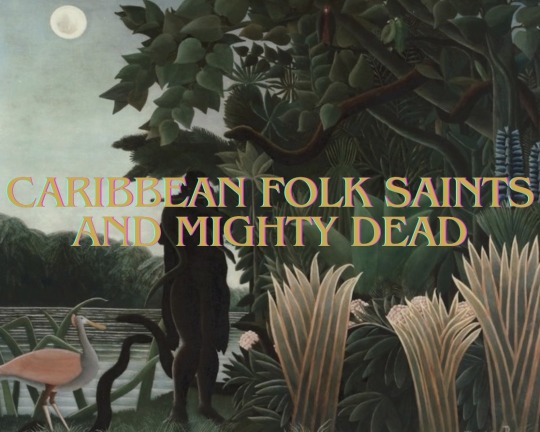
We all have family members who take on an almost Mythic quality after they pass on. They may have been a character in life, or a perhaps a spiritual practitioner. Maybe they were known for their generosity, or lack of it, or their strength or brilliance. Nonetheless, it is someone who, even in death, still makes an impact. In personal practices, we may work with these ancestors for guidance and healing, but what happens when their influence spreads past your family, into the local community or even entire country? This and many other strange circumstances often explain the origin and powers of Folk Saints and Elevated Dead. I will be going into the various Folk Saints and Deified Ancestors of the Caribbean, (including Florida), but before I can do that I need to explain where these spirits come from, and why they are so potent in our everyday lives.
What are Folk Saints and Mighty Dead?
Folk Saints and Mighty Dead are spirits of dead people who were either elevated in life, or became elevated after death. Their elevation often is then connected to their ability to grant various petitions made to them. Some of the Folk Saints I will be talking about were used to disguise other figures who were outlawed by the Colonial government at the time, while others are various figures of marginalized communities who gained sorcerous or otherworldly reputations after death.
Cuba and Florida are Lands of diaspora and syncretism. Many different traditions abound and each tradition has multiple lineages, so the classification of spirits differs depending on the worldview of the person explaining. Some practitioners work within a framework of Catholicism, some use elements and some flat-out reject Catholicism completely for decolonization purposes. For this reason, I have differentiated Folk Saints from the Mighty Dead.
Folk Saints will include those spirits who are worked with in a Catholic context, but are usually not canonized or not at first. On the other hand, the Mighty Dead will include spirits who are venerated amongst Indigenous and African traditions in Cuba as well as the surrounding areas, as to not group them under a title created by Colonizers. If you are Cuban or Caribbean, these Folk Saints and Mighty Dead offer power at a closer degree because they are more proximal to your Spirit Court, and may even already have bonds with them.
It is important to note, spirits like Orisha and Cemí have very specific protocols, manners and taboos when approaching them, so this is best done with the help of a priest, such as Oloricha or Babalawo, or a Taíno Behike. These are not energies you simply feel drawn to and work with. Orisha and Cemi are in some cases Deified Ancestors and others Personified Forces of Nature, among other things. This varies from the Ancestors and Spirits I will be discussing in this series.

Benefits of Working with The Mighty Dead
Folk Saints and Ancestors give us a closer connection to the divine through their proximity to the Divine and their individual virtues and personalities. As with all spirit relationships, you will get out what you put in.
Folk Saints who are related to the Land you live on, such as Uncle Monday or Bessie Graham for us Floridians, can help to deepen your connection with the local community. They can help you to further your relationship with the Earth and introduce you to other Land spirits.
Spirits related to your Ancestry can help to work through generational issues. Some ancestral spirits, like José Martí or Guamá for us Cubans, are related to ideas of War, Rebellion, and overcoming oppression. These spirits can be worked with for the same pursuits of defeating oppressors in the modern day. Each spirit has a story and is multi-faceted, so it really depends on what your connection is to the Spirit and what you are capable of offering them.
How to Work with Deified Dead
Working with these spirits is individual to each spirit, based on what their heritage is, as well as their personal tastes. When starting out, it’s best to keep things simple. Instead of going and creating an entire altar dedicated to a spirit, begin by praying about it at your Bóveda or ancestral altar. Here, you may find that a spirit is not compatible with your current situation, or doesn’t want to work with you ever! Should the omens be good, however, and you may begin establishing a connection to that spirit Research and talking to other devotees can give you great insight into what a relationship with that Spirit can look like.
My formula for reaching out to these spirits is always different, but I follow basic principles. I always begin with a representation of the spirit, a small offering and a candle. The representation can be anything, from a statue to a printed picture or even just their name on some paper. The offering is in most cases water until the spirit makes other wants known to me, but when a spirit doesn’t take water I offer food or tobacco instead. The candle is something I was taught helps to enhance spirit communication, carrying messages between the worlds. It is helpful to research about whoever you are attempting to communicate with, and if possible you should speak to other practitioners who work with the same Spirit. Often times, this is someone-you-know’s father or grandmother. From here, you should sit with whatever entity you are contacting, allowing yourself to experience a personal relationship with them. I will share individual experiences of what each spirit has been like in practice for me, or people I know, but for beginning this is a good basic way to start out.
I look forward to sharing more about these incredible figures who influence my favorite corner of the world to this day.
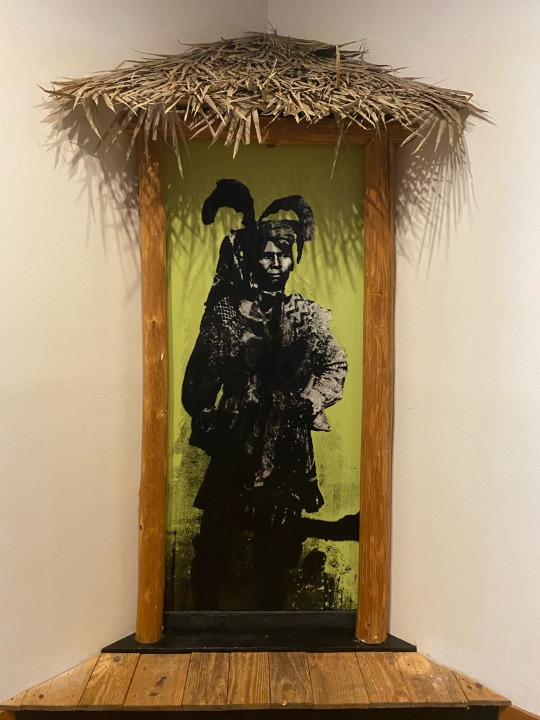
Paz y Progreso 🕯️
#witchcraft#florida#bioregional animism#bruja#brujeria#florida witch#santeria#swamp witch#witch#traditional witchcraft#cubanfolkmagic#cuban#cuba#taino spirituality#taino#folk magic#folk witch#espiritismo#atr#folkloric witch#animism
77 notes
·
View notes
Text
cannot recommend enough just walking around your neighbourhood, noticing the plants, trees, birds, creepy-crawlies, mammals, rocks, watercourses, etc that are around you. looking them up and learning about them, how they behave, their seasonal rhythms and changes. learning about their presence in folklore and mythology and culture.
these are your neighbours. if you take a few minutes to learn about them, if you make the small effort to notice them, be mindful of them on a regular basis, honour them and respect them - this is animism. this is re-enchantment.
we all live alongside and in community with a myriad of spirits. it is truly so beautiful and life-affirming and sacred to appreciate that and the unique character of your neighbour-spirits.
#animism#polytheism#spirit work#bioregional animism#some of my most beloved neighbours are the fox#the silver birch#the rowan#the cyclamen#the jackdaw and magpie#the green parakeet#the wren#the blackbird
782 notes
·
View notes
Text

Spotted these white walnuts (butternuts) on our morning walk. I’ve foraged these in the past to use in baking and natural dying and ink making.

#white walnut#butternut#foraging#Arkansas#Arkansas River valley#Ozark foothills#bioregional animism#September#native tree#natural ink
18 notes
·
View notes
Text
Meet a Plant, Know A Plant

Thanks to a link from @liminalblessings, I now have the last of the tools I need to start compiling my own bioregional herbal Materia Medica. I'm honestly tired of herbalism guides focusing mostly on European import plants. They're fine, but they're everywhere, and part of my practice is bonding with the plants I see every day.
This information comes from the traditional ecological knowledge of the Native peoples whose land I occupy. I am beyond grateful to the knowledge-keepers who have preserved this information despite all odds and shared it with anthropologists and researchers.
So now, when I meet a plant, I'm going to get to know a plant. I am lucky enough to have access to some of the primary sources thanks to my job, so this information may update as I can get ahold of more details and sources. Notion page links will be included.

As always, this is not encouragement to try these uses at home. Herbalism requires training, complex medical knowledge, and careful implementation by a specialist. Just because it's "natural" doesn't mean it's safe. This is purely for my own knowledge and understanding how people view the plants on their landscape.
14 notes
·
View notes
Text
Blorbo ask game!
Template: X
Pick your favorite blorbo and answer the questions below, then pass it on. Just a little fun and games here and/or can be used for character building:
The blorbo this time is Figwit (Maenod / Melpomaen). He's bad at picking favorites so prepare for non answers.
What is your blorbo’s:
1. Favorite season?
The summer. He finds the winter beautiful but he stands up to heat better than the cold.
2. Favorite Food?
He's fond of sweet things, cakes and fruit chief among them. I think his favorite fruit is blackberry.
3. Favorite plant or herb?
He's got a list.
The entire viola genus. Violas, violets, pansies. They're all wonderful. The multicolored yellow and purple ones are his favorite.

Violas in Snow 22218-290 by Kathy Whipple Wong+
Dandelions and orchids remind him of his parents (Glorfindel and Erestor, respectively).
He's also fond of roses, lavender, and forget-me-nots.
4. Favorite person/being?
It's hard for him to pick one person. But in the timelines where he marries, probably whoever he marries.
5. Favorite place?
In general: libraries, gardens, and close to his loved ones.
Geographically: Imladris will always have a special place in his heart. He is absolutely enchanted by the Shire and skirts around Aragorn's ban on entry to it by outsiders by making Sam's acquaintance.
6. Favorite animal?
His horse. Additionally, any horse he ever has or will lay eyes on. Loves his horses. He's very anxious about their care when he goes abroad and prefers to tend to them himself.
He also likes butterflies and moths.
7. Favorite drink?
Dandelion tea.
8. Favorite hobby/activity?
He'd probably say something different each time you ask. Calligraphy, translation, transcription, reading, text restoration and preservation, and research are all things he does regularly both at request and for enjoyment. He also enjoys horseback riding and traveling with his friends or family.
9. Do they like to read? If so, favorite genre?
He loves to read. Texts on language and culture, especially if they're either ancient or very current, are his favorite.
10. Do they like to dance?
Yes.
11. What is their favorite room in the house?
Elrond's house: it's a toss up between his own and the library.
Glorfindel and Erestor's cottage: the main room
In most other places it's usually the library or archives or other equivalent.
12. Favorite place to travel to?
Fuck if he knows.
Lothlorien, for many years. However, when he travels somewhere new, it usually becomes his new favorite place to travel to for a while unless he's found himself there under spectacularly poor circumstances.
13. Who is their best friend?
Erestor is his closest family member and Lindir is his closest friend, though Lindir also operates as family to him.
14. Favorite bioregion?
Out of practicality, more temperate regions are easier for him to handle. Harsher ones are more of challenge but he still enjoys them.
15. Choose one for them: wine, beer, cider, hard liquor, or none?
Cider. As sweet and least alcoholic as possible.
Tagged by: @parma-formenorion Also, you're it, again.
Tagging: @elithilanor and anyone who's interested
#About Mel#headcanons#Maenod | Melpomaen | Figwit#Tolkien#Lord of the Rings#blorbo ask game#//i still know fuck all about bioregions
9 notes
·
View notes
Text
Working With the Wind
Things to do with a particularly windy day:
Pay attention to the direction of the wind. In some traditions, this carries further significance. This may either be a set of rules based on the cardinal directions or, as in my practice, based on local landscape. Winds coming down from the mountains are different than those blowing in from the prairies.
Do mundane research on wind. How is it formed? What causes it? How does it interact with plants and animals? When is it windiest where you live? How does this information affect your craft?
Capture the wind and save it for later. In folklore, sailors would tie favorable winds into knots and untie them later out at sea. It also works great in summertime when you just want a nice breeze.
Banish something in the wind. Take whatever you don’t want in your life and let the winds carry it far, far away. Let blessings and other work travel on the wind, they can also reach great distances with the help of the wind.
Connect with deities, especially those associated with storms, nature, and the element of air. Leave out an offering for wind spirits. Celebrate them the same way you might celebrate the spirits of the first snow or spirits of summertime.
In winter, winds are sometimes connected to the Wild Hunt and similar lore involving mass amounts of spirits riding in on the wind. Or perhaps you follow a tradition that holds that spirits are less likely to appear in the wind due to their nonphysical nature.
Lastly, if you need protection from a windstorm, try placing a knife in the earth with the blade facing into the wind. This is said to cut up a storm and prevent it from bringing harm.
Sources & Further Reading:
- The Crooked Path by Kelden
- Spirits Through Respiratory Passages, Eldar Heide
- GKOS
71 notes
·
View notes
Text
Creating a Backyard Land Spirit Profile
Working with land spirits can help connect you with your local ecosystem, and for some practitioners is a crucial aspect of bioregional magic. Some folks, like myself, consider themselves to be initiated by one or more land spirits.
When I use the term land spirits, I am referring to a few different things. First are the collective spirits of various plants, animals, and insects present in a specific bioregion. An example of collective, in this context, means that if I'm petitioning help from the spirit of violets, I am working with the spirit of all violets present in that area rather than a singe flower that grows in my yard.
The next is the land guardian, which in my practice is a more powerful spirit with claim over a specific territory, like a forest, river, or neighborhood.
Sometimes these two concepts are separate and sometimes they're interchangeable. It all depends on personal practice, culture, local folklore, etc.
One thing that has been extremely beneficial to my practice has been creating a backyard land spirit profile. This method has been useful for spirit work and "green" magic, but more importantly, it's helped me immerse myself in my local ecosystem and I get to meet a lot of cool animals and plants.
Here is an over-simplfied example of my backyard land profile:
Ecosystem: Central Interior and Appalachian: Mixed woodlands, close to possible floodplains
Soil Type: Clay in garden bed, Loamy near/beneath shrubs, Sandy in sunny areas of the lawn
Flora:
Cultivated- Paradise Apple, Highbush Blueberry, Rose of Sharon, Dog Rose, Black-Eyed Susan, Sundial Lupine
Native - Bloodroot, Wild Strawberry, Common Violet, Wrinkle-Leaf Goldenrod, Blue Wood-Aster, Horseweed, Fireweed, Deer-Tongue Witchgrass, Common Milkweed
Invasive - Round-Leaved Bittersweet, Yellow Toadflax, Creeping Bellflower, Common Mugwort
Naturalized - Dandelion, Broad-Leaf Plantain, Deadly Nightshade
Notes - Various mosses, unidentified mushrooms growing on lawn and lichens found on some trees/shrubs.
Fauna:
Mammals - Raccoon, Opossum, Striped Skunk, Grey Squirrel, Chipmunk, Feral Cats, Deer mouse, House Mouse
Birds - Cardinals, Chickadees, Catbirds, American Robin, Downy Woodpecker, Turkey Vulture, Crow
Reptiles and Amphibians - N/A
Fish - N/A
Invertebrates - Dotted Wolf Spider, Leopard Slug, Tiger Bee Fly, Monarch Caterpillars, Peach Root Weevile, Narrow-Winged Mantis, Fireflies
Ecoregion and Soil Type
The first thing I did was determine what type of ecosystem my yard used to be. In an urban/suburban area this was a bit challenging.
I started by identifying a few wild plants and finding out where they usually grow. Most of them seemed to prefer shady woodlands and rich soil. There were also a couple of pioneer species present in the sunnier and more disturbed areas of the yard.
Next, I took a look at surrounding wild areas. We are close to a mountain and a large river. There are woodlands near and within the city made up of mostly hardwood and conifer trees. I knew from memory that certain areas close to my home are likely floodlands.
After that, I found a bioregion map of my country which showed that my state fell under the category of Central Interior and Appalachian. I searched this region on landscope.org and was able to determine my specific ecoregion (not shared here for privacy reasons).
From there I started making educated guesses. I determined that my backyard was likely a mixed hardwood and conifer woodland sitting very close to what might have been a floodplain.
For my soil type, I took samples from different areas of my yard and used an online guide to determine what kind of soil I had. Most of it was sandy or loamy, but my flower beds seemed to have some clay.
Using all this information, I had a general idea of what kind of plants and wildlife would be present without human intervention. It also helped with deciding which native plants to start growing.
Plants
Throughout the year, I went out to the yard with a wildlife field guide and a couple identification apps and identified every plant and insect I found. I grouped the plants into four categories: native, invasive, naturalized, and cultivated. This isn't shown in the example, but I also grouped them by season and the time of year they appear.
Naturalized refers to plants that have integrated themselves into the environment without inflicting damage to the local ecosystem.
You'll notice that under the cultivated section I included a few native plants. This is because those plants were introduced by me and would not be present without my intervention and I wanted to make that distinction.
The importance of native and naturalized plants is obvious, but what about cultivated and invasive? Keeping a profile of invasive plants helped me keep a record of which noxious weeds I need to remove. From an ecological perspective, their removal is crucial to the survival of my native plants and garden crops. From a spiritual perspective, this can be an offering or act of service to the local land spirits. Some of these plants, like Common Mugwort, are both valuable for workings and fine to harvest in large quantities since they are invasive.
Cultivated plants are also important. Many of these plants, like my Blueberries, Apples, and Rose of Sharon, were here before me. The importance of plants introduced by humans is greater than you'd think. First, they are usually crops and flowering plants and provide food for both humans and the local wildlife. Secondly, I live in an urban area, and my land spirits are likely very closely associated with people.
I researched all of my plants and took note of growth patterns, toxicity, medicinal uses, ediblity, native region/habitat, ecological significance/impact, etc. Then I moved onto folklore and symbolism and started working with the spirits of a few plants, performing divination, leaving offerings, harvesting them and including them in rituals and spellwork. I did this in groups to avoid feeling overwhelmed.
Please note that you should always properly identify plants and be aware of potential toxicity before harvesting, especially if you plan on burning or consuming said plant. Also steer clear of protected or threatened plants and keep harvest to a minimum even for abundant native species.
Wildlife
My next project was writing down every species of animal and insect that I had encountered in my yard. I grouped them into several categories: mammals, birds, reptiles, amphibians, fish, and invertebrates. In real life my invertebrates section is separated into several subcategories (orb weavers, beetles, etc.).
Next, I used basically the same system I did for plants, researching their native range, preferred habitat, behavior, diet, ecological importance. Then I started looking into folklore.
Finally, I started integrating them into my practice and working with their collective spirits. This involved using animal symbolism in rituals, leaving offerings, and performing a lot of divination.
Remember to never interact with or directly feed wildlife. If I'm making offerings outdoors it is usually fresh water, scattered birdseed, and acts of service like creating habitats and growing plants that a specific species enjoys. If scattering birdseed, do so in the morning to keep too many animals, like raccoons, from entering your yard at night.
Side note: Keep a record of what appears in your yard each year! For example one year we had several chipmunks and one year I saw none. One year we had no fireflies and the next our backyard was covered in them.
Tying It All Together
Once I had my backyard profile completed, I started working with the collective spirits of select species. I have an offering schedule, perform communication, and petition these spirits regularly in spellwork. I use certain plants that I harvest for offerings and use for tinctures, infusions, cooking, and crafts. I use symbols of local animals in crafts and spellwork.
After working with the "smaller" spirits, you can start seeking out specific land guardians by using a combination of divination and research of local history and folklore.
On a mundane level, I am now able to cultivate an appropriate ecosystem for the local wildlife and start projects to support it. Examples of this are pollinator gardens, stick and brush piles for fireflies and small animals, growing seed-rich and fruiting plants for birds and mammals, winter shelters and TNR plans for feral cats, and more.
I also like to take notes on plants and wildlife that I encounter in my general area that don't usually make it into my backyard. For example there have been coyotes, foxes, bobcats, and black bears spotted in my neighborhood.
I want to stress that I live in a semi-urban and relatively populated neighborhood and I have a small yard. The brief example of of my land profile doesn't cover even a fraction of the wildlife I have encountered in my backyard. There is so much life in urban and suburban areas in need of our support.
#bioregional magic#spirit work#green witchcraft#land spirits#witchcraft#plant magic#local witchcraft
31 notes
·
View notes
Text

Mother Death has paid us a visit again, with one of our old hens passing away in the night. Accordingly, we took her body out into the forest, where we laid her to rest in the embrace of a Nurse Stump and showered her with Bleeding Heart Flowers—a bioregional plant we have found quite useful as a Ghost Corn for the spirits of the dead.
#hen#death#chthonic rituals#ghost corn#bleeding hearts#bioregional paganism#tw: dead animal#bone mother
26 notes
·
View notes
Text
I saw a post some time ago about a non Cultus Sabbati reading list for Sabbatic Craft,, might make one to get the brain moving
2 notes
·
View notes
Text
Resources for Cuban and Caribbean Folk Magic 🇨🇺
Disclaimer: Cubans are not a monolith so when we say ‘Cuban Folk Magic’ its like saying ‘American Folk Magic’ in the sense that it is a BROAD term that includes multiple different cultural threads and traditions. Start by researching your ancestors and where they were from as a jumping off point.
Also, many of these resources are not Cuban themselves, but they either share the same practices or are academic or general sources. I have made it clear when a source isn’t Cuban. For this reason, I have expanded it to be the Cuban AND Caribbean Folk Magic List.
The List
Creators:
Irka Mateo - Taino - Insta 🇩🇴
Religion.Ancestral.Taino - Insta 🇵🇷
Sancista Brujo Luis - Espiritismo/Taino-Youtube | Blog 🇵🇷
OkaniLuna - Brujería/Taino - Youtube🇩🇴
Juliet Diaz - Brujería/Taino/Author - Instagram 🇨🇺
Sancista 7 Espadas - Espiritismo - Insta 🇵🇷
Odofemi - Regla de Ocha - Tumblr 🇺🇸
Eve the Medium - ATR/Espiritismo - Youtube 🇩🇴
Yeyeo Botanica - ATR/Espiritismo- youtube 🇺🇸
Botanica Candles & More - Great Podcast!! - youtube 🇨🇺 🇺🇸
Connecting w/ Guides and Goals by Adunola - youtube 🇺🇸
Hatuey Museum of Archaeology, Baracoa, Cuba - Taíno archaeologists photos and blog - Link
Florida Memory - Photos and Articles on Folk History of Florida and surrounding areas - Link
Articles
San Lazaro - Wikipedia - Novena - Yeyeo Botanica
Caridad del Cobre - Wikipedia
Orisha and Palo Herbs Directory- Website
Ewe (Herbs) Photo Guide - Website
Pueblo Originario Taino Section - Website
Taino and Agua Dulce essay by Jorge Estevez - Link
Memoir of Florida’s Indigenous People by Hernando Escalante de Fontaneda - Link
Tacachale: Essays on Indigenous Floridians by Milanich and Proctor - Link
Huellas Indigenas en Cuba - Taino Spirituality in Cuban Folk Magic Article - Link
Books:
Taino Library* - Amazing resource for books of all kinds, many books about Taino and Caribbean Spiritualities, Folklores and Songs! Multiple books on Cuban Myths and Folktales! Highly recommend - Website 🇵🇷
Espiritismo by Hector Silva🇩🇴
A Year in White by C Lynn Carr
The Modern Art of Brujería by Lou Florez(VERY BASIC just as a general introduction to what alot of modern Folk Practices look like)
American Brujeria by J. Allen Cross 🇲🇽🇺🇸
El Monte by Lydia Carbera 🇨🇺
Palmetto Country by Stetson Kennedy - Link
Movies and Videos:
Cecilia (1982) - Youtube
Las Profecias de Amanda - Youtube
Susie Jim Billie, Medicine Woman Interview - Link
Proyecto Cuba Indigena - Link
Miguel Sague, Taíno Spirituality - Link
**This list will grow as I find more resources that are reliable enough to share. If you have recommendations or would like to be added, please reach out.
Luz y Progreso 🕯️
(I also have included a Research Guide below the Cut!)
Guide to researching based on your ancestry:
If your family has African roots, you can seek Ocha/Lukumi, Palo, Arara, Cuban Vodou and other African Traditional Religions and Practices. Please approach elders within these respective practices to further your connection to them, rather than using books to create a practice for yourself. These are ancient, community based and are lifelong commitments, not just trendy powerful spells for you to get what you want.
If your family has indigenous roots, research Taino spirituality and modern practices , but also know that there were other tribes in the western and centeral parts of Cuba, with their own languages and traditions you can still learn about like the Guanahatabey. You may also consider joining a Yukayeke, but this isn’t required. Reconnecting and decolonizing is a separate and important topic that is not inherently witchcraft or folk magick-y… HOWEVER, researching and informing yourself with these practices can help you to see their influence within modern folk practices.
If your family has Asian roots, research the buddhist cults and folk practices throughout Cuba! Believe it or not, we also have people of Middle Eastern descent in Cuba who brought with them their own Hindu and Arabic Folk Traditions, which can be found throughout Cuba and the Caribbean as a whole.
If your family has Spanish roots, research some open practices like Espiritismo and Folk Catholicism! Look into the Patron Saints of Cuba, La Virgen de La Caridad del Cobre and San Lazaro. These also tie in to many of the other cultures who were forced to adopt certain elements to ensure survival of their traditions! You can also look into Brujería. Much like modern witchcraft, modern brujería has been commodified to hell and back, but there is still some great knowledge and power to be found there.
The fact of the matter is, that most of us can fit ourselves into two or more of these categories, and this crossover is where Folk Magic is often born. Its also important to note, in alot of these traditions you shouldn’t learn or share certain things at certain times, so some sources who share too much about Ocha and other ATRs should be avoided. Also, I can’t stress how important it is to talk to your family! Ask them about folklore or legends and stories! Also research history and folkore of the specific areas in Cuba your family is from. A-lot of folk magic is incorporated into stories.
Bendiciones, good luck on your Journey!🦎🐊

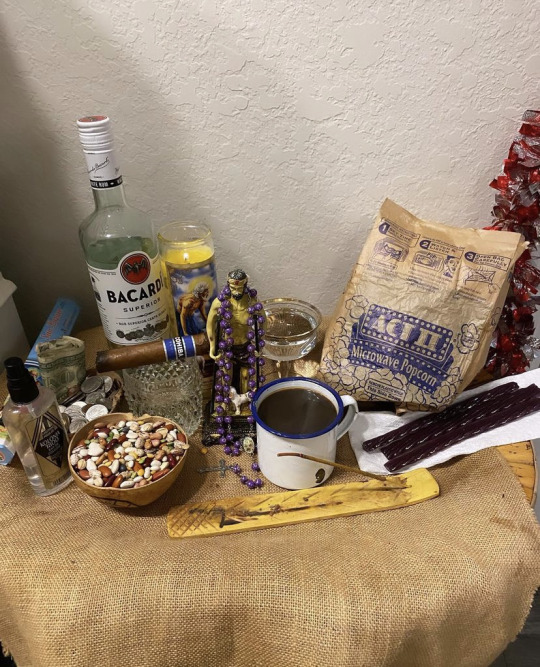
#witchcraft#bioregional animism#bruja#brujeria#santeria#cuba#cuban#espiritismo#mediumship#florida#florida witch#swamp witch#witch#traditional witchcraft#taino#taino spirituality#folk magic#folk witch#folk witchcraft#resource list
84 notes
·
View notes
Text
This is a good post on how to start thinking about localising your practice to your area or bioregion - something that's been really meaningful for me personally. Some good prompt questions to consider!
55 notes
·
View notes